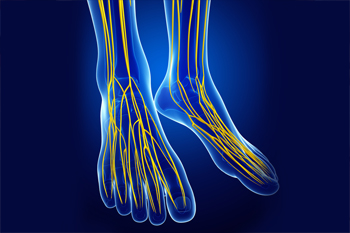What Is Tarsal Tunnel Syndrome?
Tuesday, 17 August 2021 00:00Within the ankle lies a narrow structure composed of bone and tissue— known as the tarsal tunnel. Running through this tunnel are blood vessels, tendons, and the tibial nerve—which can become compressed in this narrow anatomical space due to a lesion, mass, or other contributing factors that increases pressure within the tunnel. Tarsal tunnel syndrome is an entrapment neuropathy which can cause symptoms that may include tingling, burning, numbness, or a shooting and radiating pain in the ankle or along the tibial nerve. People with flat feet are said to be more prone to developing tarsal tunnel syndrome as the tibial nerve can become stretched due to fallen arches. Patients who believe that they have Tarsal Tunnel Syndrome should consult with a podiatrist. There are a variety of treatments and therapies a podiatrist has at their disposal to help relieve pain and decompress the affected nerve.
Tarsal tunnel syndrome can be very uncomfortable to live with. If you are experiencing tarsal tunnel syndrome, contact one of our podiatrists of Family Foot Care. Our doctors can provide the care you need to keep you pain-free and on your feet.
Tarsal Tunnel Syndrome
Tarsal tunnel syndrome, which can also be called tibial nerve dysfunction, is an uncommon condition of misfiring peripheral nerves in the foot. The tibial nerve is the peripheral nerve in the leg responsible for sensation and movement of the foot and calf muscles. In tarsal tunnel syndrome, the tibial nerve is damaged, causing problems with movement and feeling in the foot of the affected leg.
Common Cause of Tarsal Tunnel Syndrome
- Involves pressure or an injury, direct pressure on the tibial nerve for an extended period of time, sometimes caused by other body structures close by or near the knee.
- Diseases that damage nerves, including diabetes, may cause tarsal tunnel syndrome.
- At times, tarsal tunnel syndrome can appear without an obvious cause in some cases.
The Effects of Tarsal Tunnel Syndrome
- Different sensations, an afflicted person may experience pain, tingling, burning or other unusual sensations in the foot of the affected leg.
- The foot muscles, toes and ankle become weaker, and curling your toes or flexing your foot can become difficult.
- If condition worsens, infections and ulcers may develop on the foot that is experiencing the syndrome.
A physical exam of the leg can help identify the presence of tarsal tunnel syndrome. Medical tests, such as a nerve biopsy, are also used to diagnose the condition. Patients may receive physical therapy and prescriptive medication. In extreme cases, some may require surgery.
If you have any questions please feel free to contact our offices located in Valatie and Albany, NY . We offer the newest diagnostic and treatment technologies for all your foot and ankle needs.




